










|
|
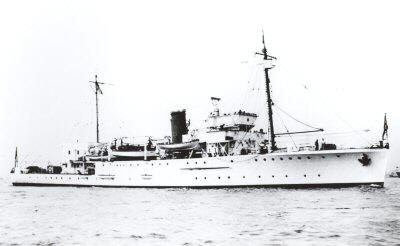
HMS Scott 1954
|
Principal Surveys 1946 |
R
Bill |
England, East Coast.
Scotland, East Coast. |
Humber approaches;
Yarmouth to Winterton.
Approaches to Rosyth. |
|
1.46-2.46 |
At Chatham |
|
3.46 - 6.46 |
Refitting at Sheerness |
SCOTT, meanwhile, under Hennessey, completed surveying Brest in
comparative leisure since there was little strategic urgency, and
then was given a rapid refit at Grimsby. Fully fit again, and now
under Bill, she was put to work on the east coast of England
between the Downs and the Humber assisting minesweepers in
clearance work, and locating and sweeping some of the many wrecks
in the channels between the cast coast sandbanks.
Source: EXTRACTS from: Charts and Surveys in
Peace and War – The History of the RN Hydrographic Service 1919 –
1970 by Rear Admiral R O Morris CB
|
|
6.46 -11.46 |
Surveying in Home Waters |
|
Principal Surveys 1947 |
R
Bill |
England, East Coast.
Scotland, East Coast. |
The
Humber; Approaches to Yarmouth and Lowestoft.
Inverness and approaches. |
|
22.4.47 |
In collision with
trawler PRINCE VICTOR, minor damage |
|
Principal Surveys 1948 |
RH
Griffiths |
England, East Coast. |
River Medway. Thames estuary; River Stour. |
|
Principal Surveys 1949 |
R
H Griffiths |
Scotland, West Coast.
England, East Coast. |
Firth of Clyde.
Approaches to Colne and Blackwater Rivers. |
In January 1949
we cut short our lie-up in order to prevent the ship's company
being raided due to man-power shortages and sailed for the Clyde.
Geoffrey Haskins
|
|
Principal Surveys 1950 |
R
H Griffiths
W
Ashton |
England, East Coast.
England, South Coast |
The Naze to Orfordness
Poole Bay and Western Approaches |
|
Principal Surveys 1951 |
W
Ashton
J
C Grattan |
England, South Coast. |
Start Bay, Nare Point to the Manacles; Straight Point to Portland;
Shoreham; Dartmouth. |
|
29.1.51 |
In collision with tug
EXPELLER in the Medway, port side damaged; repaired at Chatham |
|
Principal Surveys 1952 |
J
C Grattan |
England, South Coast.
Wales, West Coast.
North Atlantic |
Lyme Bay; Dartmouth;
Newhaven; Salcombe.
Milford Haven.
Oceanography with RRS
Discovery II. |
|
Principal Surveys 1953 |
G
P D Hall |
England, East Coast.
England, South Coast.
Ireland, East Coast.
Wales, West Coast. |
Thames estuary.
Lyme Bay.
Strangford Lough.
Milford Haven. |
On 15th June 1953 Scott took part in the
Coronation Review of the Fleet at Spithead along with HMS
Sharpshooter.

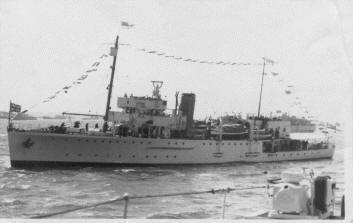
Photos of HMS
Scott at Dartmouth preparing for the Review and during the Review
(Source: Bryan Senior)
Memories of my time onboard - Bryan Senior, Radio Electrical Artificer 4th Class
HMS Scott 1952-53
● I helped set up
the equipment to record echoes from the
explosions that "Discovery" set off when
investigating the Earths Crust in the Atlantic.
● I was one of the
crew of the ships boat that got stranded in Loch
Strangford while trying to do one more track
just as the tide was going out (The loch
is famous for rapid tide changes). They had to
send another boat to take us off and leave our
boat until the tide changed, we had to wade out
to the rescue boat as it didn't also want to get
stranded.
● While surveying
the Thames Estuary using "Decca" for doing
fixing, but also using the radar because it was
foggy, I was ordered to be the radar operator
because the normal operator was sick.
You can imagine
my panic as the captain kept giving idents to
each echo I reported then coming back asking
where such a particular one was now. (We are not
trained to read PPI screens)
Suddenly
one appeared dead ahead and I reported it as we
got closer. The captain over the speaker said to
me "That's a Buoy, ignore it" then the engines
went into full astern as a large tanker loomed
up out of the fog dead ahead.
You can imagine
the comments I got about how useless radar was
when I got back to the Mess but the Captain sent
for me and apologised for making a wrong
assumption (Possibly a trained operator may have
told the captain the echo was to large to be a
buoy.)
● The Scott had two
large motor launches (Like MTBs) that worked
either side of us giving quick multiple runs.) I
was summoned to the bridge by the captain who
rather irate told me to look into the "Walky
Talky" that he was using to communicate with the
boats as it kept failing.
I had to
diplomatically demonstrate to him that these
phones were "Line of sight" only operation, so
that as he got rigging etc between himself and
the boats that was why they didn't work.
● Acting as a guest
ship at the Spithead review we were one of the
last to take position and were anchored just
astern of the Russian cruiser. I remember that
as the queen sailed down the lines of warships
they all gave little "Pops" of their saluting
guns until she passed the Russian Cruiser,
as they didn't have a saluting gun, they just
fired one of their anti aircraft guns which was
a great deal louder than all the others.
|
|
|
|
|
Principal Surveys 1954 |
C
R K Roe |
England, East Coast.
Wales, West Coast.
England, South Coast |
Thames Estuary.
Milford Haven.
Lyme Bay. |
|
Principal Surveys 1955 |
N
D Royds |
England, East Coast.
England, South Coast. |
Thames Estuary; The
Downs.
Anvil Point to St
Catherine’s Deep. Wreck sweeping. |
|
Principal Surveys 1956 |
H
R Hatfield |
England, East Coast.
Shetland Islands.
England, South Coast. |
The Wash, Boston Deep.
Oceanography.
Anvil Point to Owers;
Sandown Bay. |
|
Principal Surveys 1957 |
|
|
Extended refit for
whole of year |
|
Principal Surveys 1958 |
G J
B Simeon |
Scotland, East Coast. |
Approaches to Aberdeen;
Peterhead harbour and approaches; Approaches to Wick; Firth of
Forth; Oceanography. |
|
Principal Surveys 1958 |
G J
B Simeon |
England, East Coast.
Scotland, East Coast. |
Thames Estuary;
Approaches to the Humber Bank; Dogger Bank.
Firth of Forth. |
|
Principal Surveys 1960 |
D
P D SCOTT |
England, South Coast.
England, East Coast. |
Dungeness to the Goodwin Sands.
Approaches to Humber. |
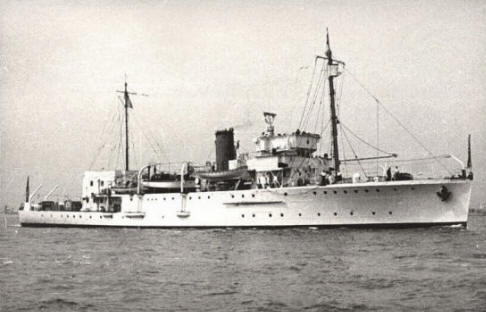
HMS Scott
On the theme of unusual paint schemes, in 1960 I was drafted to
HMS SCOTT based at Chatham, Kent. My previous unit had been the
shore base HMS Sultan in Gosport, the engineering school. I asked
around but no-one seemed to have heard of the SCOTT.
I had married during my leave and having never having a Chatham
ship before I arrived adrift having come on the train the longer
route. I used the last of my money on a taxi from the station. The
Cox'n, on my joining, was not very impressed. As I had previously
passed for PO I was informed that I was the Killick of the stokers
mess, and doing PO's duties down the boiler room.
At sea, we wore "Survey Rig". HMS SCOTT was a survey ship engaged
on East Coast Survey, anywhere from Dover to the Humber. Our task
was to survey for wrecks and establish their height and position
with great accuracy. Wrecks of two world wars and before. This
was when the thought of 50 ft draught supertankers were just an
idea on the drawing board… When I joined her she was painted white
with a buff funnel, SURVEY COLOURS.
Loads of sea time. It was usual to anchor when it got dark and
start again at first light. I learned about tide watching with our
survey launch (something I never did) and wire sweeping was
ongoing all the time. Drift sweeping to establish the height of a
wreck. Two days anchored in the Dogger Bank with the engines going
to keep her nose into the sea. The machinery (Steam Turbines of
1750 shp and Boilers at 250 psi.) The boilers had been de-rated
and nothing much worked as it should. No 'Robo' feed regulator on
the boiler but all the latest radar and slave stations for
accurate navigation. What a great way to learn the job.
http://smmlonline.com/archives/VOL1883.txt |
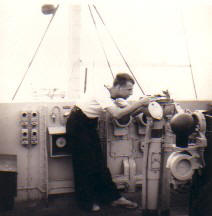
HMS Scott - 1960 - UK East Coast Survey
http://www.teeweb.co.uk/Trevswebbies/TrevswebbiesFrameset.htm
|
Principal Surveys 1961 |
WJM Roberts |
England, South Coast.
England, East Coast. |
South Foreland to Dungeness.
Orfordness to Lowestoft; Approaches to the Humber; Outer Dowsing. |
|
Principal Surveys 1962 |
WJM Roberts
W M Powell |
England, East Coast.
Scotland, East Coast. |
Orfordness to
Southwold; Sizewell Bank; N E Approaches to the Wash.
Wee Bankie.
Also visited Helsinki
for an exhibition ‘Navigare ‘63’. |
|
|
HMS Scott a personal view by Derek Kimber Oct 2008
I served aboard
HMS Scott as a Junior Radio Electrical mechanic from January 1962
until October 1962.
Scott was my
first ship after training at HMS St Vincent and HMS Collingwood. I
joined her in refit at Chatham where we spent about a month prior to
proceeding to sea for survey off the East Anglian Coast. It was
during this period that one of our ships survey boats was stranded
at Liverpool Point due to fog whilst tide watching.
Our base port
during this survey was Grimsby and I remember many nights sleeping
in the warehouses on the jetties having missed the last boat out to
the ship, and, as a junior suffering the wrath of the Chief Tiff on
return.
The ship was
canteen messing and as the junior I was expected to peel the spuds
each evening for the mess whilst the more mature mess members
prepared the main course (usually potmess or Pork chops!). I slung
my hammock in the Starboard passageway outside the canteen door and
was constantly disturbed as ships crew members purchased extra
supplies of canned beer to keep them going!
The ship leaked
like a sieve and was either freezing cold or swelteringly hot
dependant on the outside temperature. I spent several nights
sleeping in the Boiler Room airlock to keep warm.
During the
summer of 1962 we moved up to survey off of Scotland and I was put
ashore at a place called Cowbenspath near to Dunbar to man one of
the two 2 Range Decca navigator stations used to fix the ships
position. I had received no training on this equipment but was
there only because the two ratings who normally manned it had
cleared off on long weekend having left the station running until
the diesel generator failed and it went off air. I stayed at the
site which was on the top of the cliffs in a remote field on my own
for about 6 weeks as I recall, eventually returning to the ship at
Leith in Scotland, the base port for the summer survey.
The ship worked
constantly during surveying and every member of the crew was
expected to carryout bridge duties taking Echo Sounder readings and
noting the Decca fixes into the survey log. The rig at sea was
survey rig or anything to keep you dry and warm. I left the ship in
October 1962 having learned some valuable lessons in life and had a
very rude awakening when I joined HMS Nubian a spanking new Tribal
Class frigate of the proper Royal Navy!
|
|
1962 |
The final resting place
of the submarines K4 and K17, 140ft below at the bottom of the
Forth, 13 miles from the Fife coast, was only discovered in 1962 by
HMS SCOTT. |
|
Principal Surveys 1963 |
W
M Powell |
Ireland, North Coast
England, East Coast
Scotland, East Coast |
North Channel to Lough Foyle, Portrush; Portstewart.
N E
Approaches to the Wash; Outer Silver Pit.
Arbroath and approaches. |
|
31.10.63 |
Minor damage from
collision with wharf at Grimsby |
|
Principal Surveys 1964 |
R
P F Martin |
England, South Coast.
England, East Coast.
Scotland, East Coast. |
Portland Exercise Areas.
Outer Silver Pit; Southern North Sea.
Approaches to Leith; Montrose. |
|
20.11.64 |
Arrived Chatham to pay
off |
|
27.11.64 |
Arrived Portsmouth to
lay-up |
|
24.6.65 |
Sold to West of Scotland
Shipbreaking; towed to Troon, arriving 3.7.65 to break up. |
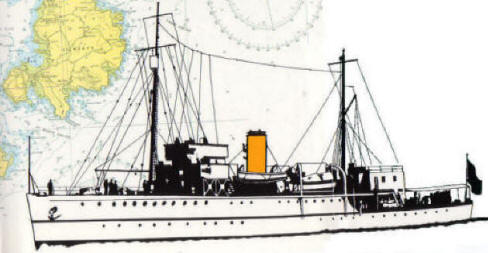 |

